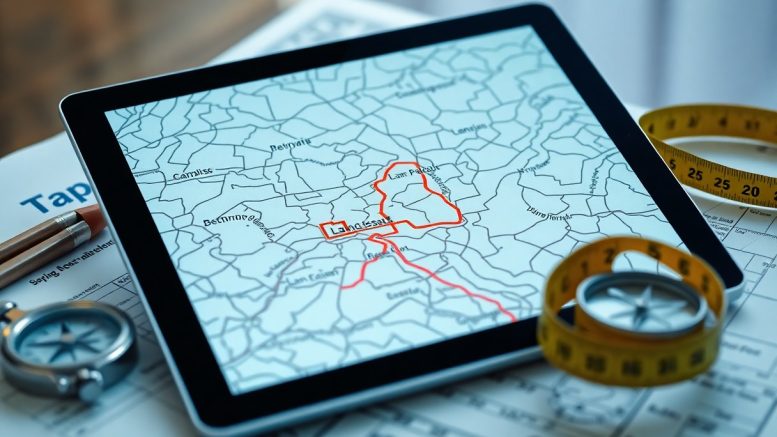LandRecords are imperative for maintaining accurate land ownership and property rights, yet many people overlook the importance of digitizing easements. By transitioning these documents into a digital format, you ensure greater accessibility, enhanced accuracy, and improved management of your land records. This process not only minimizes the risk of disputes but also streamlines the retrieval and updating of information, leading to more efficient land transactions and a clearer understanding of property boundaries. Embracing digital solutions can significantly benefit your land management practices.
The Necessity of Accurate Land Records in Modern Governance
Accurate land records serve as the backbone of effective governance, impacting everything from property taxes to urban planning. Governments rely on these records to ensure equitable distribution of resources and to uphold legal rights associated with land ownership. Errors can lead to disputes over ownership, misallocation of funds, and hindered economic development. In a rapidly changing world, reliable land records enhance transparency, foster trust among stakeholders, and streamline the administrative processes necessary for efficient governance.
The Role of Easements in Land Use
Easements are vital components of land use, granting specific rights to individuals or entities over another’s property, often allowing access or utility installation. Understanding the nuances of these rights helps to navigate complex land use scenarios, ensuring that property development adheres to legal frameworks while balancing the needs of landowners and the community. Proper documentation of easements prevents conflicts and promotes harmonious land use practices, contributing positively to diverse interests.
Implications of Inaccurate Land Records on Property Rights
Inaccurate land records can severely undermine your property rights, leading to legal disputes and potential loss of ownership. Ambiguities in record-keeping may result in overlapping claims, where multiple parties assert rights over the same piece of land. This chaotic scenario can escalate to costly legal battles, significantly impacting your financial stability and property value. Moreover, inaccuracies delay transactions, complicate estate planning, and can thwart efforts for development or improvements on your land.
Transforming Easements: The Digital Revolution
Digitizing easements heralds a transformative era in land management, streamlining processes and enhancing accessibility. By integrating digital records, you gain real-time access to data, facilitating quicker decision-making and reducing the risk of errors associated with paper-based systems. Enhanced visualization tools, such as GIS mapping, also allow you to easily comprehend complex land use scenarios, benefiting both landowners and stakeholders alike.
The Technological Shift Towards Digitization
The rise of cloud computing, mobile applications, and advanced mapping technologies has made digitizing easement records not just feasible, but important. Transitioning from traditional paper records to digital formats enables you to access, update, and manage your easement information from anywhere, providing unprecedented flexibility. This shift fosters transparency and collaboration among all parties involved in land transactions.
Benefits of Digital Easement Records over Traditional Methods
Digital easement records significantly surpass traditional methods by ensuring greater accuracy, efficiency, and accessibility. With automated updates and real-time data, you can minimize discrepancies and quickly address any changes in land status. Digital platforms also enhance security, as electronic files are less susceptible to physical damage or loss compared to paper documents.
Transitioning to digital easement records brings many advantages to your land management practices. Not only does it streamline the administrative burden, but it also reduces costs associated with paper storage and retrieval. Enhanced search capabilities allow you to quickly find specific easements, while integrated systems can alert you to deadlines and renewals. Moreover, digital records can be easily shared among stakeholders, improving collaboration and expediting negotiations. By embracing a digital approach, you ensure that your land records are not only accurate but also future-proof against evolving technology and practices in land management.
Addressing Barriers to Digitization
Digitizing easements faces several barriers that can hinder progress. Often, financial constraints limit the budgets available for new technology. Additionally, many organizations struggle with the lack of trained personnel who can manage and implement digital systems effectively. Resistance from stakeholders fearing disruption of established processes can further stall initiatives. Overcoming these challenges requires a targeted approach tailored to the unique circumstances of each organization.
Common Challenges in Implementing Digital Systems
Implementing digital systems often encounters resistance due to inadequate infrastructure and the complexity of transferring vast amounts of existing data. Organizations may face data inconsistency issues, where legacy records do not match current legal requirements. Furthermore, cybersecurity concerns can discourage decision-makers from transitioning to digital solutions, as they prioritize the safeguarding of sensitive information above all.
Strategies for Overcoming Resistance to Change
To effectively navigate resistance, you can foster a culture that embraces innovation by engaging stakeholders early in the process. Providing training sessions that highlight the benefits of digitization is necessary; these sessions can address specific concerns and demonstrate the efficiency gains realized through digital systems. Additionally, presenting successful case studies from similar organizations can help build confidence in the proposed changes.
Encouraging collaboration among departments and inviting feedback creates a sense of ownership among your team. Establish regular check-ins to discuss progress and obstacles, reinforcing that their input is valued. Offering incentives for early adopters and recognizing their contributions can motivate others to embrace the transition. By addressing fears and emphasizing the advantages of digital records—such as improved accuracy and easier access—you can create momentum for lasting change. Implementing a phased approach enables gradual adoption, minimizing disruption while allowing for adjustments based on initial feedback, ensuring a smoother transition to digital easements and land records.
The Future of Land Management: System Integration
Future land management relies on robust system integration to enhance efficiency and accuracy in property records. By unifying existing databases and tools, land managers can create a comprehensive framework that supports real-time updates and seamless communication across different platforms. This interconnected approach not only optimizes workflow but ultimately leads to better decision-making and resource allocation within land management operations.
Interconnected Systems and Data Sharing
Interconnected systems facilitate enhanced data sharing between municipal offices, landowners, and various stakeholders. Implementing open data protocols allows for greater accessibility and transparency, leading to more informed decision-making. This ecosystem thrives on shared information, reducing redundancies and minimizing the risk of errors in land records.
Enhancing Transparency and Accessibility for Stakeholders
Greater transparency in land management enhances stakeholder engagement by making information easily accessible. By digitizing easements and related records, you empower various parties—from community members to developers—to understand property rights and restrictions. This proactive sharing of knowledge fosters collaboration, reduces disputes, and strengthens trust among stakeholders.
With the digitization of easements, you can access vital information without lengthy bureaucratic hurdles. For instance, online portals provide instant access to maps, easement documents, and updates, allowing landowners to stay informed about their property rights. Enhanced transparency also encourages public participation in land use planning, leading to more community-centered development efforts. Case studies have shown that jurisdictions implementing these systems report increased citizen engagement and a reduction in the number of disputes related to land ownership and use, underscoring the benefits of accessible information in promoting harmony in land management.
Cultivating Stakeholder Engagement in Digitization Efforts
Effective stakeholder engagement serves as a foundation for successful digitization initiatives. By involving landowners, local authorities, and other vested parties from the onset, you can identify specific needs and concerns, ensuring the digitization process aligns with community interests. Engaging stakeholders promotes transparency and encourages collaboration, which can ultimately lead to smoother implementation and greater acceptance of digital land records.
The Importance of Communication with Landowners
Clear communication with landowners fosters understanding and cooperation regarding digitization efforts. When you provide consistent updates about the process and its benefits, you address potential concerns and invite input. Open dialogues allow landowners to feel involved and valued, which enhances their willingness to support and participate in the digitization of easements.
Building Trust in Digital Land Records
Establishing trust in digital land records is necessary for widespread acceptance. You need to demonstrate the reliability and accuracy of the information being digitized. Highlighting successful case studies, implementing robust security measures, and adhering to transparent data management practices can reassure stakeholders about the integrity of digital systems. Offering training sessions helps users feel more comfortable navigating new technology, further solidifying their trust.
Successful digital land records systems have shown how transparency builds trust. For example, jurisdictions that have engaged communities through regular public forums report higher levels of documented support for digitization efforts. By showcasing user-friendly platforms and involving landowners in feedback loops, these systems not only gain acceptance but also promote ongoing improvements that reflect user needs. Tools like online maps with real-time updates exemplify how digital records can enhance user confidence and engagement.
Conclusion
Presently, digitizing easements is crucial for maintaining accurate land records, as it enhances accessibility, efficiency, and precision in land management. By converting physical records into digital formats, you can ensure that your property rights and obligations are clearly documented and easily accessible. This practice not only minimizes disputes but also supports informed decision-making regarding land use and development. Embracing digital methods allows you to effectively manage your land-related information, ultimately leading to better compliance and protection of your interests.






Be the first to comment on "Why Is Digitizing Easements Critical For Accurate Land Records?"